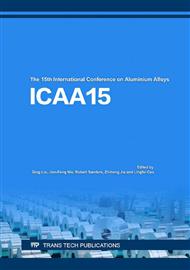p.625
p.635
p.640
p.647
p.655
p.662
p.668
p.674
p.680
Numerical Analysis of Wavy Interface Formation and Successive Temperature Change in Magnetic Pulse Welded Al/Cu Joint
Abstract:
Magnetic pulse welding (MPW) which is one of the impact welding methods is suitable for a wide variety of combinations of similar and dissimilar metals. The flyer plate is accelerated by electromagnetic force and collided to the parent plate. A characteristic wavy interface is formed. The impact velocity and impact angle of the flyer plate during impact are important parameters which affect the interface morphology. In the case of dissimilar metals (e.g. Al/Cu, Al/Fe), the intermediate layer (such as intermetallic compound (IMC)) is formed by wavy interface formation and local temperature increase. The intermediate layer often decreases the bonding strength. Wavy interface formation mechanism and temperature increase at the joint interface should be investigated in order to obtain the dissimilar metal joint with high bonding strength. In this study, the impact velocity and impact angle of the flyer plate were obtained by using ANSYS Emag-Mechanical. Based on the obtained impact velocity and impact angle of the flyer plate in the MPW, the wavy interface formation and temperature change were reproduced by using ANSYS Autodyn for solving non-liner dynamics problems. Al sheets and Cu sheets were joined by the MPW. The joint interface was observed by OM and SEM and compared to the simulation result.
Info:
Periodical:
Pages:
655-661
Citation:
Online since:
November 2016
Authors:
Price:
Сopyright:
© 2017 Trans Tech Publications Ltd. All Rights Reserved
Share:
Citation:


